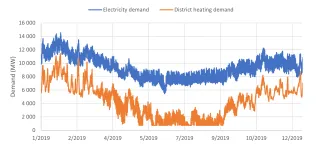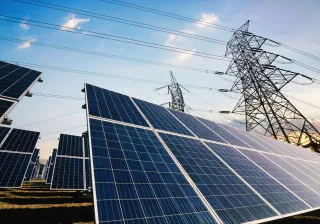The European energy sector is in transition. The ongoing energy crisis means this transition is more visible now than ever before in the day-to-day operation of energy systems and is also strongly shaping the near-future outlook of the whole sector. Although the emission reduction targets have long guided the development of the energy sector towards the same direction, the crisis has further accelerated the transition, underlining the pressing need for it. The transformation towards a low-carbon Europe was always considered as an immense effort, but the current speed will make it even more dramatic.
Renewables and emission-free energy supply are needed both for electricity and for heating and cooling. As a result of the ongoing transition, these energy carriers will be more interconnected than before. In addition to the direct impacts of emission reductions, this is how the heating and cooling sector can be an integral element in the overall decarbonisation effort through sector coupling.
In the case of, e.g., Finland, this interconnection is already here. Large-scale district heating (DH) systems, combined heat and power (CHP) production and the increasing utilisation of heat pumps, part of the heat supply – combined with the advanced electricity market Nordpool, mean that the sector integration between heating and electricity systems is already strong. However, the significance and opportunities related to it are just starting to grow. The scale of the combined national DH systems makes this interesting. Figure 1 shows the aggregated district heating demand (estimated) and electricity demand[1] for Finland in 2019. The seasonal variation in electricity demand is due to electrical and heat pump-based heating, so the peak demand for the entire heating sector is actually higher than the other electricity demands. Oil, wood and other biomass-based building-specific heating (such as pellets) are not accounted for here.

Figure 1. Total district heating and electricity demand in Finland in 2019.
Crucial technologies to meet the decarbonisation goals
The decarbonisation of the heating and cooling sector is a challenging undertaking of its own. On a European level, there is a lot of ground to cover. Renewables only account for 23% of heating and cooling[2] while representing about half of the energy consumption.
The two key technologies crucial in meeting this challenge are district heating and cooling (DHC), and heat pumps. The first is, first and foremost, a technology for distributing heat or cooling, ideally produced as efficiently as possible and taking advantage of local resources. This distribution network is often quite extensive and can potentially be sprawled across entire cities. This translates into a massive, connected demand. The second, the heat pumps, is a heat and/or cooling supply technology that uses electrical energy to transfer heat from a lower temperature level into a higher level with very high efficiency. Heat pumps have a variety of applications and will form an essential part of the future supply. The pumps represent a low-carbon solution for heating and cooling as the decarbonisation of the electricity production advances.
Whether we consider large-scale units connected to DHC or building-specific heating or cooling, the energy supply is undergoing an electrification. Although renewable fuels still have a part to play, traditional combustion-based heat supply is changing.
Sector integration offers flexibility
One of the most important characteristics of an energy system utilising sector-coupling is its flexibility. Here, thermal energy storage solutions are an interesting option. They offer the most economically viable solution for storing energy in large-scale. Together with an electrified heat supply and a large, connected heat demand (i.e., district heating system) they provide a significant opportunity for balancing intermittent renewable power production. This represents a largely untapped potential for city-wide district heating and cooling systems, increasing the value of this existing infrastructure – or representing a case for an investment in a new area, a city, or a country.
Another representation of sector integration is the utilisation of excess heat from the industry and other potential heat sources within an urban environment, like data centres. Large-scale utilisation of excess heat can only be implemented if a district heating system is there to make use of it. One specific future source of excess heat might be hydrogen production. If realised, the hydrogen economy would represent a huge excess heat potential and could be a significant economic opportunity for the heat supply of large-scale district heating systems – and vice versa.
The examples offered here on sector integration opportunities within the heating and cooling sector are mostly based on electrification, and a stronger connection with the power system. However, the need for flexibility, utilisation of new renewable or excess heat sources, and the increasing storage capacity can potentially also shape the heating market itself. The market structure especially of district heating can potentially become more like the electricity market, i.e., dynamic pricing reflecting the current market conditions more accurately, e.g., on an hourly basis. This could provide an incentive for distributed heat supply (hybrid systems) to accommodate the changes in heat supply costs in an efficient way. It could also represent a harmonious solution for coexistence of building-specific and a (more) centralised heat supply.
The significance of the heating and cooling sector was already recognised six years ago by the EU in its heating and cooling strategy[3]. However, introducing the identified solutions there has so far been slow. The current crisis and the realised risks will change this in the coming years.
A mild winter and decisive, concrete actions on the research, development and implementation pathway regarding the heating and cooling sector should be on the wishlist for all European countries.
References:
[1] Fingrid open-data; https://data.fingrid.fi/en/
[2] EC: Heating and cooling; https://energy.ec.europa.eu/topics/energy-efficiency/heating-and-cooling_en
[3] An EU Strategy on Heating and Cooling; https://eur-lex.europa.eu/legal-content/EN/TXT/PDF/?uri=CELEX:52016DC0051&from=EN
Sector integration: Towards a carbon neutral energy system
This white paper explores sector integration as a phenomenon and presents ways in which the whole society as well as individual stakeholders can benefit from the opportunities of this systemic transition. Download our sector integration whitepaper here.






